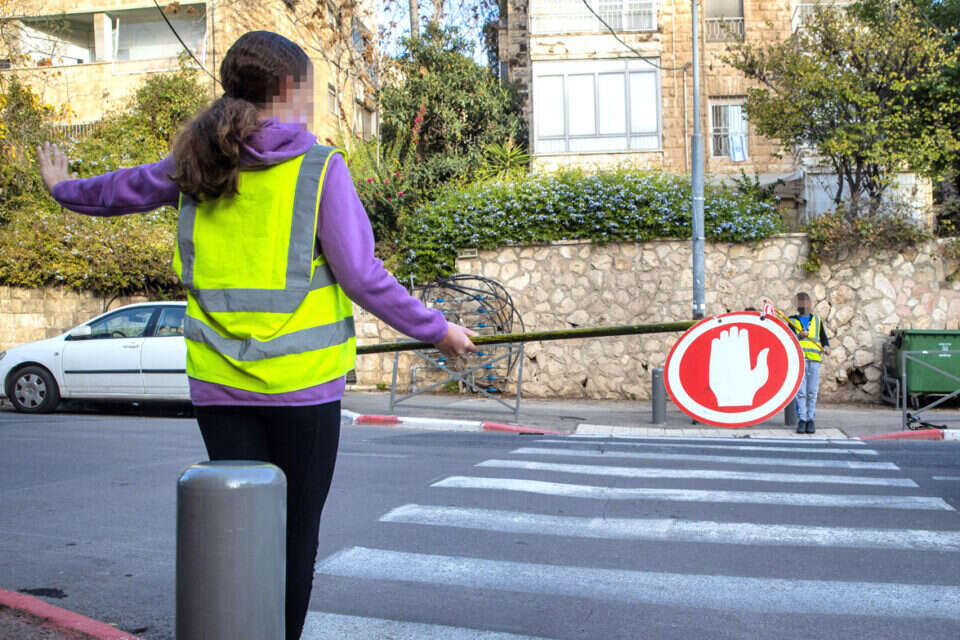The Zahav shifts program is supposed to provide a solution for crossing students' roads, but documentation from several places throughout Israel paints a very worrying picture.
The Age of Avnei Kiryat Shmona
Zahav shifts have no trace
In the elementary schools in Kiryat Shmona, there are no Zahav shifts. In the early hours of the morning, there is a long line of parents dropping off their children on the street near the Maginim school in the city.
Most children arrive at school with their parents, and only a few of them use public transportation or arrive on foot from nearby homes.
A lot of patience is evident in the place on the part of the other drivers, who already seem to be used to the traffic jams and congestion near the opening hours of school hours.
Some parents choose to take the children out of the vehicle in a traffic jam on the road, without parking the vehicle.
For a brief moment the door opens, and a small child jumps out and walks himself to school.
Minutes pass, and the traffic almost stops.
A lot of patience on the one hand - and an organized mess on the other.
Parking is a bit far from the school and almost empty - parents choose not to use it.
One parent chooses to park the vehicle for a moment on the sidewalk, quickly gets out of the vehicle and takes the child out of the back seat.
A tour of the other schools in the city reveals: There are no Zahav shifts operating throughout the city. It is the parents who help the children cross the roads.
Transport chaos at the entrance to the school - Ilya Yagurov
Beer Sheva
"Our school also participates in a road safety program," reads the sign at the entrance to the Neve Menachem school, named after the neighborhood in Be'er Sheva.
Only what is actually happening shows that it is very far from reality, to say the least, and closer to chaos: cars and trucks drive in both directions, parents drop off their children right on the road, and in the middle - children cross the road near the school diagonally and run fast.
Moreover, there is not even a single crosswalk near the school.
One crosswalk is at the beginning of the street, and to cross the road safely the children are required to make a turn, so many parents give up the "pleasure" and choose to take a risk.
"It's a dangerous environment," says one of the mothers.
Another grandmother accompanies her granddaughter every morning, even though they live within walking distance of the school.
"He himself is afraid to move here, not just us," she shares.
There is nothing to talk about Zahav shifts: these do not exist either. The parents themselves are divided between those who drop off their children in an orderly place, and those who choose to do so in the middle of the road, when in some cases the child is dropped off on a side with vehicle traffic. The road, although it is possible to advance another 100 meters to a traffic square, while the others shout and honk.Most parents are aware of the danger of the same place, and accompany their children hand in hand to the school gate - but themselves pass in the middle of the road.
Children Crossing a Busy Street, Without Assistance - Yuri Yalon
Jerusalem
Two crossings are located at the entrance to Ben Lebert Street in Jerusalem, where the Rehavia State Elementary School, named after David and Paula Ben-Gurion, and the AD Rothschild Girls' School, are located in the two educational institutions in the Rehavia neighborhood. In the capital, many male and female students study.
A three-student road guard with glowing vests showed up Sunday morning at 7:25 a.m. at a crosswalk on the bustling Tudela Street in the neighborhood, while at the nearby crosswalk there were no IDF shifts - and children passed it themselves unattended and unintentionally. These are primary school-aged children, boys and girls aged 11-5, some of whom have passed through a crosswalk without adults or the assistance of Zahav shifts, with vehicles entering the street one after the other.
This situation could endanger the safety and security of the young students, who make their way to the schools on Ben Lebert Street every day through the crosswalk, where there is no supervision.
Some parents entered with their vehicle into the street where the schools are and dropped off their children at the entrance, while other parents stopped their vehicle near a local bus stop, their children got out of the vehicle and walked alone on their way to school.
Most of the drivers who passed by in the morning obeyed the Zahav shifts and were patient, but there were cases where the drivers ignored the requests of the shift attendants, who did their shift professionally and courteously, and seemed to have undergone appropriate training to prepare them for their mission successfully.
The drivers are patient and obey the students - Yaron Doron
At the "Ahad Ha'am" elementary school in Hadera, students from first grade to sixth grade study.
In this school, only the senior class, ie sixth graders, function every morning for the Zahav shifts. The students do this in turn, so that each student goes out to perform such a shift once a month. Those who have shifts arrive early at school, already at 7 o'clock. In the morning, compared to the other students, who arrive around 8:00 a.m., they receive a briefing from one of the teachers, wear glowing vests, take the sticks with the "stop" sign, and walk toward the crosswalks. At 7:30 a.m., they begin the shift.
Teachers share and guide
Near the school there are three crossings, and in each of these a pair of pupils is placed, each pupil at a different end of the crossing.
In addition to the six students stationed at the crossings, there is a student defined as the shift commander.
He moves between the crossings, making sure everything works properly.
One of the teachers explains to us that the students who participate in the Zahav shifts are trained by the person in charge of road safety in the Hadera municipality. Crossing - The stick is raised, and the vehicles continue to travel.
Almost all of the school's students cross the crossings on their way to the school day.
Even though it is a main street, the drivers are patient and obey the student signs, allowing all the accompanying students and parents to cross safely.
Authority in the hands of the students: This is how the Zahav - Noam (Devol) Dvir system works
The Zahav Guards (Road Safety) is a program that has been in operation for more than 50 years, in which sixth-graders help pedestrians, especially students, to safely cross roads at the crosswalks near the schools.
One of the questions that arises is: How are the roads and crosswalks on which these students are to be placed determined?
Those who determine where the students will be placed are training police officers - police officers who have been authorized by the Traffic Division of the Israel Police to serve as instructors of the IDF.
The decision is related to the physical and engineering conditions in the vicinity of the crossings, as well as to the number of crossings adjacent to the schools, taking into account the level of risk of the Zahav shift students themselves.
But there is another issue that is influencing - and that is the number of sixth-graders studying at the school, who rotate in the position.
That is, the load that will be placed on them and the degree of their erosion from their activity in the Zahav shifts must be taken into account. This means that the fewer adult students there are, the less the chance of optimal coverage of safe crossings.
In the morning shift, students must report to the crosswalk half an hour before school begins, and finish the shift five minutes after they begin.
At noon, they will arrive five minutes before the first-fourth grades graduate.
The duration of the noon shift will be determined by the Zahav coordinator, depending on the location of the crossings, and the length of the shift will be at least 20 minutes.
The principal of the school must notify all the parents of the students of the cancellation of the Zahav shifts in special cases: in exceptional weather conditions - sleet or stormy weather - or in cases where the shifts students are in another activity that does not allow them to carry out the Zahav shifts activities.
In these cases, the school principal will inform the educators, and they will take care of conveying the message to the students' parents.
The parents of the young students (in grades 1-4) should be informed that they must accompany their young children to school, due to the temporary inactivity of the Zahav shifts.
Were we wrong?
Fixed!
If you found an error in the article, we'll be happy for you to share it with us









/cloudfront-eu-central-1.images.arcpublishing.com/prisa/57W3XJJOEVD6DPVJCW54P3NVUE.jpg)





